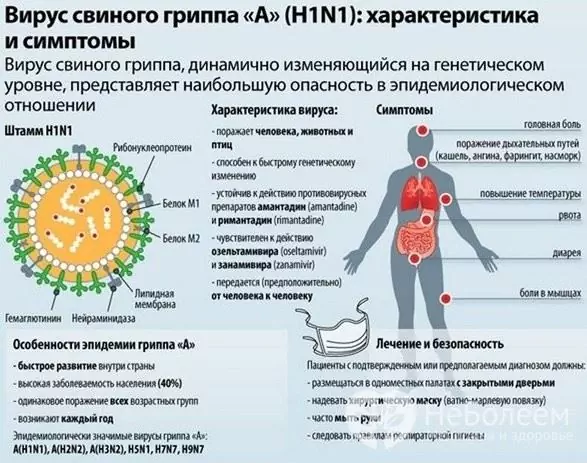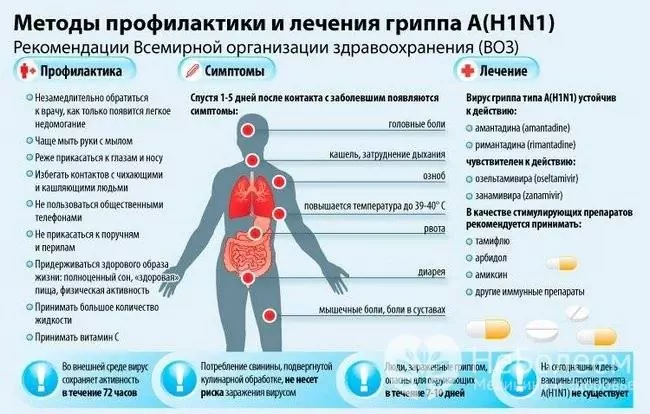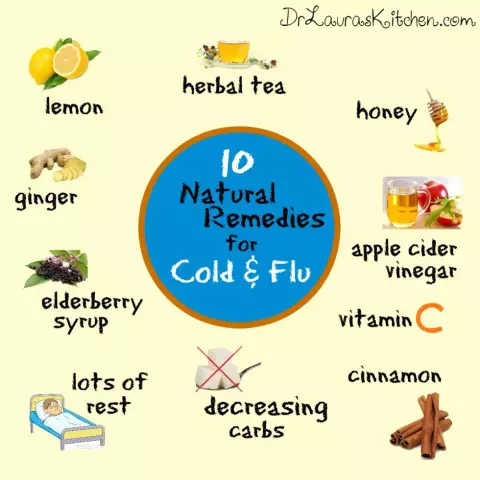- Author Rachel Wainwright [email protected].
- Public 2023-12-15 07:39.
- Last modified 2025-11-02 20:14.
Swine flu
The content of the article:
- Causes and risk factors
- Swine flu symptoms
- Diagnostics
- Swine flu treatment
- Potential consequences and complications
- Forecast
- Prevention
Swine flu (California flu, Mexican flu, North American flu, Mexican flu) is an acute viral respiratory illness caused by certain strains of the flu virus.
The swine flu virus was isolated in 1930 from domestic pigs in Mexico and North America. For many years, the virus circulated in limited areas and caused disease only in animals. Since the 90s of the XX century, isolated cases of swine flu have been recorded among pig breeders and veterinarians.
Over time, mutations have led to the emergence of a new strain of the swine flu virus, which has acquired the ability to cross the interspecies barrier and be transmitted from person to person. In the spring of 2009, the virus began to spread widely among humans, causing a pandemic called "California / 2009". According to the WHO, it covered 74 countries. The new virus was easily transmitted from person to person and caused more than half a million people to become ill. Therefore, the WHO has assigned the highest hazard class (IV class) to this swine flu virus.
In 2016, infectious disease specialists predicted a new outbreak of swine flu and put the virus strain causing it into a vaccine. This made it possible to create a fairly wide immune layer among the population of a number of countries where this vaccine was applied. But, despite this, the virus has spread significantly, in particular in Israel, Turkey, Russia, Ukraine.

Source: arpeflu.ru
Causes and risk factors
Swine flu is caused by strains of influenza viruses of serotype A (A / H1N1, A / H1N2, A / H3N1, A / H3N2 and A / H2N3) and serotype C. All of them are collectively called "swine flu virus".
The most dangerous epidemiologically is the serotype A / H1N1. Its occurrence is the result of the recombination (mixing) of several subtypes of the virus. It was this strain that caused the 2009 swine flu pandemic. The properties of the A / H1N1 virus are:
- the ability to infect birds, animals, humans;
- the ability to be transmitted from person to person;
- the ability to make rapid changes at the gene level (mutations);
- resistance to the action of traditional antiviral drugs (remantadine, amantadine).
The swine flu virus has little resistance in the external environment. Ultraviolet rays, disinfectants quickly inactivate it. However, at low temperatures, it remains virulent for a long time.
Sick or infected people and pigs are sources of swine flu infection. In the human population, the infection is mainly transmitted by airborne droplets. The contact-household transmission path is much less common. Cases of infection associated with the consumption of meat from infected pigs are not described in the medical literature.
The patient becomes infectious to others from the last days of the incubation period and releases viruses for another 10-14 days from the onset of the disease, even with specific therapy.
Susceptibility to swine flu caused by the A / H1N1 virus is high. Most often, the disease occurs in patients with a reduced immune status:
- young children;
- pregnant women;
- elderly people;
- suffering from somatic diseases;
- HIV-infected.
Replication and reproduction of the swine influenza virus occurs in the epithelial cells of the mucous membrane of the respiratory tract, which is accompanied by their degeneration and necrosis. Viruses and their toxic waste products enter the bloodstream and are carried throughout the body. Viremia persists for 10-14 days and is manifested by toxic lesions of internal organs and, first of all, the cardiovascular and central nervous system.
Damage to the cardiovascular system is accompanied by microcirculation disorders, increased fragility and permeability of blood vessels. These changes, in turn, lead to the appearance of hemorrhagic skin rashes, nosebleeds (rhinorrhagias), and hemorrhages into internal organs. Microcirculation disorders contribute to the formation of pathological processes in the lung tissue (edema, hemorrhage in the alveoli).
Against the background of viremia, there is a decrease in vascular tone. Clinically, this process is manifested by the following signs:
- venous hyperemia of the mucous membranes and skin;
- congestive plethora of internal organs;
- diapedetic bleeding;
- thrombosis of capillaries and veins.
All the described changes on the part of the blood vessels cause hypersecretion of the cerebrospinal fluid and disturbance of its circulation, which leads to an increase in intracranial pressure and can cause cerebral edema.

Source: simptomer.ru
Swine flu symptoms
The incubation period for swine flu lasts from 1 to 7 days. The clinical manifestations of infection are varied. In people with weakened immunity, the disease is very difficult and often ends in death. In some patients, it, on the contrary, is asymptomatic and can only be detected when antibodies to the virus are detected in the blood serum (asymptomatic virus carrier).
In most cases, the signs of swine flu are similar to those of seasonal flu or SARS:
- intense headache;
- photophobia;
- an increase in body temperature up to 39-40 ° С;
- aches in muscles and joints;
- weakness, lethargy, feeling of weakness;
- Pain in the eyes;
- sore throat and sore throat;
- dry cough;
- runny nose.
In 40-45% of cases, swine flu is accompanied by the development of an abdominal syndrome (diarrhea, nausea, vomiting, cramping abdominal pain).
Diagnostics
The preliminary diagnosis of the disease presents many difficulties, since the symptoms of swine flu and the usual seasonal flu are similar. The final diagnosis is made on the basis of the results of laboratory tests that allow identification of the pathogen:
- examination of a smear from the nasopharynx by PCR;
- virological examination of the detachable nasal cavity;
- serological tests (ELISA, RTGA, RSK).
Serological tests for suspected swine flu are performed twice with an interval of 10-14 days (paired sera method). The diagnosis is considered confirmed in the case of an increase in specific antibodies by 4 times or more.
Swine flu treatment
Treatment for swine flu includes symptomatic and etiotropic agents.
Etiotropic therapy is aimed at suppressing further viral replication. It is carried out with interferons (alpha-2b interferon, alpha interferon), kagocel, zanamivir, oseltamivir.
Symptomatic treatment of swine flu is carried out with antihistamines, antipyretic and vasoconstrictor agents. If indicated, detoxification therapy is performed (intravenous infusion of glucose and electrolyte solutions).
Antibiotics are indicated only when a secondary bacterial infection is attached. In this case, use macrolides, cephalosporins or penicillins.

Source: simptomer.ru
Potential consequences and complications
Swine flu can lead to serious complications, many of which are potentially life threatening:
- pneumonia (viral, secondary bacterial);
- infectious and allergic myocarditis;
- respiratory distress syndrome;
- pericarditis;
- meningoencephalitis;
- hemorrhagic syndrome;
- respiratory and cardiovascular failure.
Against the background of swine flu, the patient experiences a significant decrease in overall immunity, as a result of which concomitant somatic diseases are aggravated.
Forecast
The outlook is generally favorable. Most people with swine flu are mild and recover completely within 10-14 days. Severe forms of swine flu develop in 5% of patients, usually immunocompromised individuals. Swine flu is fatal in 3-4% of cases.
Prevention
In order to prevent swine flu, it is recommended:
- lead a healthy lifestyle;
- wash your hands regularly and often with soap and water;
- avoid contact with people with signs of respiratory illness;
- include enough fresh fruits and vegetables in the diet;
- observe the regime of work and rest.
Vaccination is the most effective prevention measure. First of all, the vaccine against swine flu is necessary for certain categories of the population.
- Persons who, by the nature of their professional activities, have a high risk of contracting swine flu and infecting other people with this disease. This category includes medical workers, military personnel, workers in the field of trade, education, transport, social services.
- Pregnant. During pregnancy, the risk of severe swine flu increases 3-4 times. Studies have not revealed an embryotoxic or teratogenic effect of the vaccine, but it is safest to be vaccinated against swine flu in the II or III trimester of pregnancy.
- Patients suffering from chronic diseases of the respiratory, cardiovascular, endocrine and central nervous systems, kidneys. This is due to the fact that their swine flu is often complicated by viral pneumonia, which leads to the development of respiratory distress syndrome and death.
- Patients with immunodeficiency states, including HIV-infected.
- Children over 6 months old and elderly people. According to statistics, the highest incidence rate is recorded in these age groups of the population.
- People caring for children in the first half of their life. Breastfeeding is not a contraindication for vaccination.
Vaccination should be carried out in the fall and repeated annually. Numerous scientific studies have proven that the swine flu vaccine is highly effective and safe. In most cases, there are no serious side effects from its use. A small number of patients after vaccination have a slight fever and mild malaise, which do not require treatment and go away on their own after 24-48 hours.
Contraindications for vaccination against the swine flu virus are:
- allergy to egg white and vaccine components;
- exacerbation of chronic diseases or acute febrile conditions (in this case, vaccination is carried out during remission or after recovery).
With mild acute intestinal diseases and acute respiratory viral infections, the swine flu vaccine can be done immediately after the body temperature has returned to normal and the patient's general condition has improved.
YouTube video related to the article:

Elena Minkina Doctor anesthesiologist-resuscitator About the author
Education: graduated from the Tashkent State Medical Institute, specializing in general medicine in 1991. Repeatedly passed refresher courses.
Work experience: anesthesiologist-resuscitator of the city maternity complex, resuscitator of the hemodialysis department.
The information is generalized and provided for informational purposes only. At the first sign of illness, see your doctor. Self-medication is hazardous to health!






